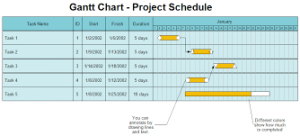Lori Benson, who is an specialist contract manager, in her article for the PM Times for Project Managers, “4 Key Project monitoring steps to help you succeed”, talks about a critical aspect of a project Control and monitoring of a project. She starts her article with a short but important statement “Trust, but verify”
In the first couple of paragraphs she explains “why” she wrote the article, affirming that Project Monitoring is necessary in all Project Management Plans, verification should take place frequently trough the lifecycle of the project, and results of that control should not only be shared to supervisors, managers and top executives, but also they should be shared with the project participants. Helping you to get a successful flow of information, results, feedback and advice throughout the project. The 4 steps are explained below.
- Begin with a plan for project monitoring
Just like the milestones exercise that we applied in class, planning how to monitor could give the project a backbone and short term objectives. Project managers have to plan for how, when and what project they want to monitor, based on realistic targets and metrics. And it have to be regularly monitored Bi-weekly or worst case scenario monthly. Monitoring is often not linear, it will have ups and downs and inevitable change throughout the project, and therefore it will have to have requested monitoring, results reviews and feedback.
Pros: You will have an efficient control of the project and you will have the opportunity to adapt and change throughout the project to mitigate risk, take advantage of positive risk and have an inside view of the project provided by feedback
Cons: I think that it could be dangerous and you could enter into micromanage your employees and that can have negative impact. Also you have to analyze the quality of feedback obtained in order to apply it efficiently into the project. Parallel you could over stress your employees like the bell example in our noodle/marshmallow exercise.
- Reports to management
The reports written or not have to have a regular schedule, weekly, monthly or bimonthly showing the progress during that period. That enables project managers to identify actual or potential problems earlier so you can make adjustments, adapt and move forward. Top managers have to be alerted if problems arouse, or if the project is having problems meeting a milestone or objective. “When reporting to organizational leadership, project leaders should focus on results that indicate whether a strategy is relevant and efficient or not”
Pros: It can help you seize opportunities of the positive side of risk, and it will help you maintain flexibility towards future events
Cons: Depending on the type of company you may have to develop a “language” to communicate effectively with Top managers. In case of public companies you may alert investors that a strategy will bring a hit in the 1st quarterly earnings but it will have a positive impact in the long term.
- Recommend actions to improve on the project
As a Project management you have to avoid recommendations without previous foundation of planning and feedback from management, communicate based on budgeting and goal-setting without sustention. Recommendations and feedback should include corrective actions, preventative actions or changes in the plan or the project execution. Guidance should be as specific as possible. “Keep in mind the team’s own health and feedback: offer constructive criticism and praise when it makes sense to strengthen the goals of the project and the team individuals’ work too.”
Pros: Feedback, guidance and adaptability can be critical to the success of a project. Applying concepts recollected from feedback can motivate employees to, like Walt Disney said “Plus it”
Cons: You have to be aware that different “qualities” of feedback and as a project manager you will have to filter information in order to have better results.
- Confirm that actions are being followed
After getting feedback and correcting the strategy, Project managers have to confirm that the changes actually are being made. Verifying also that the project as a whole is staying on track.
The author also recommends to use automated tools and technologies to track member’s performance and response, like shared documents, feedback, forecast, Gantt Charts, etc. “At the most basic level, the project leader must track the differences between what was planned, and what is actually happening to ensure that project objectives are being met”
Pros: It can help you reassure that the measures are being taken and the project is still on track. It can help you understand the stage of the project in the current time.
Cons: It could be tide back to cons of number 1 you have to be very careful with micromanaging your employees.
References: http://www.projecttimes.com/articles/4-key-project-monitoring-steps-to-help-you-succeed.html
